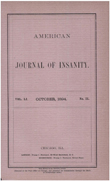Exaggerated acoustic startle reflex in Gulf War veterans with posttraumatic stress disorder
Abstract
OBJECTIVE: Exaggerated startle reflex is reputed to be one of the cardinal symptoms of posttraumatic stress disorder (PTSD). The goal of this study was to assess the magnitude of the acoustic startle reflex in Gulf War veterans with PTSD. METHOD: The eye-blink component of the startle reflex was measured in response to six blocks of pseudorandomized 40-msec white noise bursts of varying intensities (90, 96, 102, 108, and 114 dB) in 10 Gulf War veterans with PTSD, seven Gulf War veterans without PTSD, and 15 civilian subjects without PTSD. RESULTS: The magnitude of the first startle response, as well as the magnitude of startle response averaged across blocks of testing, was significantly greater in Gulf War veterans with PTSD than in veteran and civilian comparison groups. CONCLUSIONS: Consistent with some clinical studies investigating the startle response in Vietnam veterans with PTSD, this investigation provides evidence for exaggerated startle response in this disorder. Preclinical studies of shock sensitization of the startle response suggest that the higher levels of startle response seen in the PTSD subjects may reflect a sensitization of the fear/alarm response created by the stress of combat trauma.
Access content
To read the fulltext, please use one of the options below to sign in or purchase access.- Personal login
- Institutional Login
- Sign in via OpenAthens
- Register for access
-
Please login/register if you wish to pair your device and check access availability.
Not a subscriber?
PsychiatryOnline subscription options offer access to the DSM-5 library, books, journals, CME, and patient resources. This all-in-one virtual library provides psychiatrists and mental health professionals with key resources for diagnosis, treatment, research, and professional development.
Need more help? PsychiatryOnline Customer Service may be reached by emailing [email protected] or by calling 800-368-5777 (in the U.S.) or 703-907-7322 (outside the U.S.).



